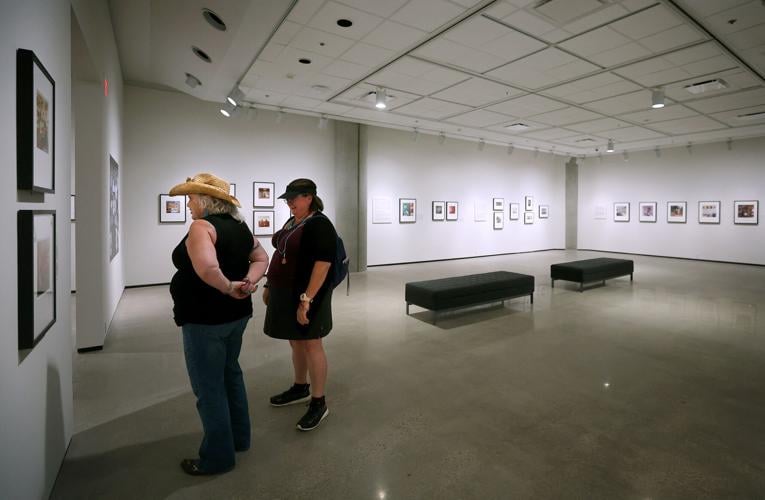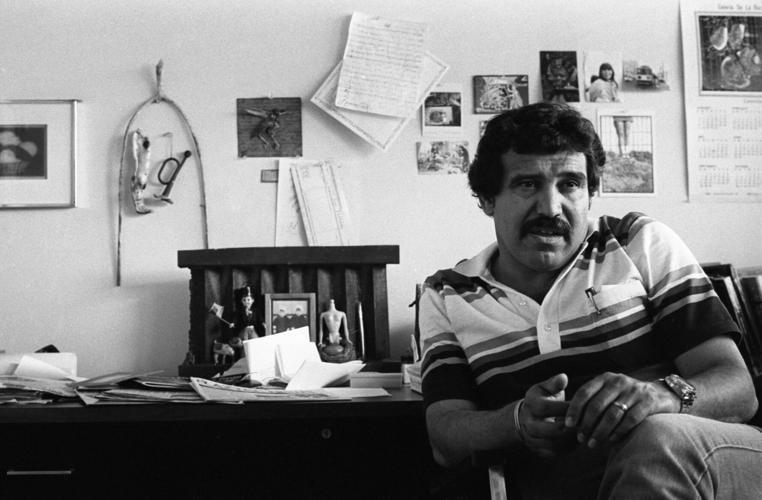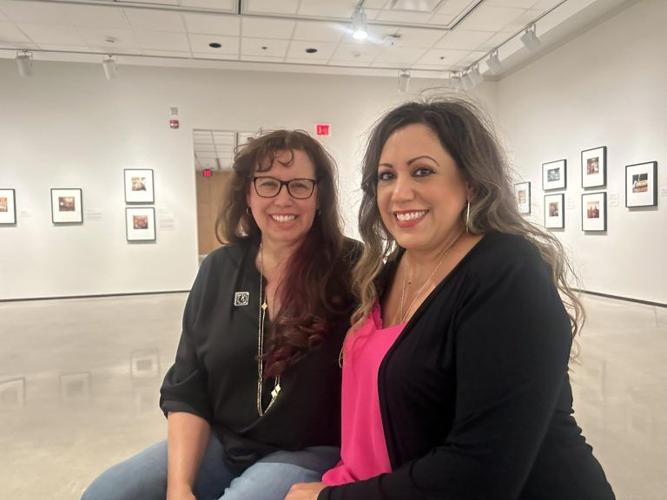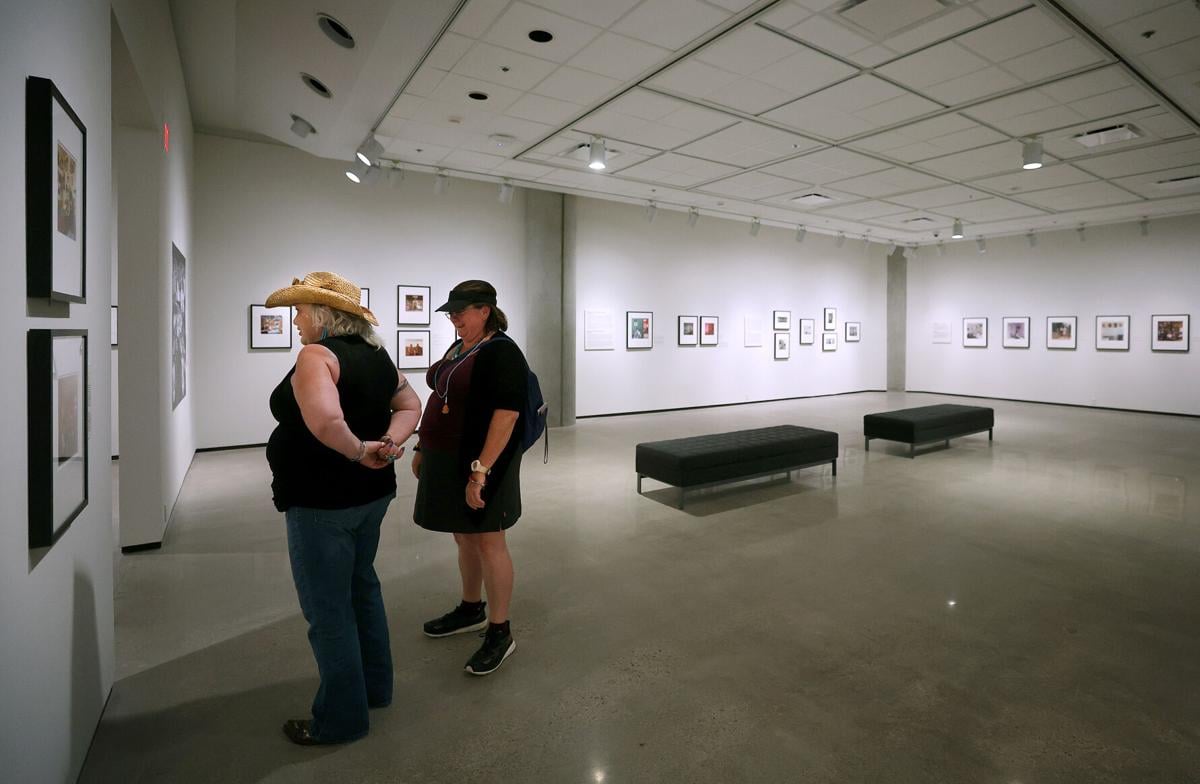Katrina Ann Bernal fondly remembers knocking door-to-door at strangers’ homes with her father in the Tucson barrios as a child.
She says her father, Louis Carlos Bernal, with his camera slung around his neck, would bring her along at 5 years old to take photographs, saying her job was to “stand there and look cute.”
“He would be like, ‘We’re just gonna go knock on the door of this house and you’re just gonna smile and be cute, and then they’re gonna let us in,’” she said. “I’d be like, ‘OK, do you know them?’ And he’d say, ‘No, but it’s OK.’”
This was how Louis Carlos Bernal, known widely in the photography world as the “Father of Chicano Photography,” captured many of his images from his Barrios series, some of which are now on display at the University of Arizona.
“Louis Carlos Bernal: Retrospectiva” premiered at the Center for Creative Photography at 1030 N. Olive Road on Sept. 14.
The exhibition, comprising more than 145 photographs and archival photographic equipment, is the first major retrospective to highlight Bernal’s career as a pioneering Chicano photographer and Tucson arts icon, according to a news release.

Lisa, left, and Katrina Bernal gifted the Center for Creative Photography the archive of their father’s work in 2014.
“Retrospectiva” displays Bernal’s portraits from the Tucson and Southwest barrios — low-income, primarily Spanish-speaking neighborhoods — along with early experimental pieces, photographs from his trips to Mexico, previously unseen images from Cuba and his perspective of the 1984 Los Angeles Olympics.

“Calendario, 1977,” by Louis Carlos Bernal, known widely in the photography world as the “Father of Chicano Photography.”
His images have religious and family ties to what he experienced as a Chicano in the 1970s and ‘80s, displaying details many Chicanos might relate to, his daughter said.
“I have a lot of Mexican-American family, and I’ve been encouraging them to come see the show because a lot of them will relate to these images on a lot of levels,” Katrina Bernal said. “I still have some family that lives very similarly to a lot of these pictures, you know, where they have the altars in their houses and stuff. So they would find a lot of respect for what my dad is showcasing from their lifestyles, and that it’s done so well.”
Louis Carlos Bernal was born in 1941 in Douglas, where he grew up. While he’d always had a fascination with photography, Bernal enrolled at Arizona State University thinking he would become a Spanish teacher. Over time, his passion for photography won out and he began experimenting with creating collages featuring former President John F. Kennedy and making abstract images out of sculptural cut paper, which are displayed in the exhibit.
“At a certain point in time, he decided that what he really wanted to do was to become an artistic photographer,” said “Retrospectiva” curator Elizabeth Ferrer. “Not a documentarian, not a photojournalist, but somebody who would use the camera as a form of artistic expression.”
Ferrer says once Bernal arrived in Tucson in 1973 to launch the photography department at Pima Community College, Bernal had an awakening about his identity as a Chicano and realized that he wanted to turn the lens of his camera on his own people.

"Martinez Brothers in Candy Store" by Louis Carlos Bernal can be seen at the Center for Creative Photography.
“He wanted to uphold the dignity of the Chicano people, the resilience and also the spirituality, which, in his terms, was something very broad, something universal,” Ferrer said. “Prior to the time that Bernal was working, Chicanos were often denigrated. They were stereotyped.”
Ferrer said Bernal often photographed his subjects in their homes, the places they’d be most comfortable, to create genuine, relatable images.
The photographer died in 1993, when he was 52, after a car accident that sent him into a four-year coma. With his photographs in only a few museum collections, his work was mostly overlooked until now.
The CCP has a long history with Bernal, exhibiting his work a few times during his lifetime and hosting a benefit auction to help pay his medical bills after his accident. Ferrer says Bernal’s two daughters, Lisa and Katrina, gifted the CCP the archive of their father’s work in 2014, and the center has since hoped to work on an exhibition in Bernal’s memory. That has finally come to fruition.

Photographer and teacher Louis Carlos Bernal in his office at Pima Community College in April 1980.
Along with curating the exhibition, Ferrer is the author of the bilingual companion book, “Louis Carlos Bernal: Monografía,” co-published by Aperture and the Center for Creative Photography. The book is the first major scholarly account of Bernal’s life and details his work that draws from “Catholicism, Indigenous beliefs and and popular practices tied to the land,” according to the book’s description.
“This is many years in the making, and we are very excited to present the work of the Father of Chicano photography,” Ferrer said. “In the same way that I think Bernal was memorializing everyday people in his work, this exhibition memorializes Bernal and gives us a really in-depth look at who he was as a person and as an artist.”
The exhibition is in both Spanish and English.
“Usually, English oversees all of our exhibitions, right? And we try to make it balanced, but there’s always going to be a hierarchy on how people are reading; we read left to right,” said CCP Learning and Engagement Manager Denisse Brito. “And this time, we wanted to make it intentional for Spanish to be the first language people are seeing, and then maybe be confused. They might be like, ‘Oh, I can’t understand this,’ and then you can see it in English. So Spanish is really the focus here.”
CCP Chief Curator Rebecca Senf said the hope with the exhibition and publication of the book is to invite scholars to do their own research and find new ways of understanding Bernal.
“This process of restoring Bernal’s legacy and placing him in the context of American art, where he belongs, is a process that we’re all participating in,” Senf said. “Each person who reads an article or comes to the show is part of this process of bringing his story back into broad understanding, and so we’re really excited to be at the beginning of that process and really excited to invite people to participate in that with us.”
“Louis Carlos Bernal: Retrospectiva” will remain on display at the Creative Center for Photography until March 15. The CCP is open 10 a.m. to 4:30 p.m. Wednesdays through Saturdays. Learn more at ccp.arizona.edu.
Walking tour of the historic Barrio Viejo neighborhood south of downtown Tucson. Text by Bobbie Jo Buel. Photos by Mamta Popat. Produced by Rick Wiley / Arizona Daily Star 2020









